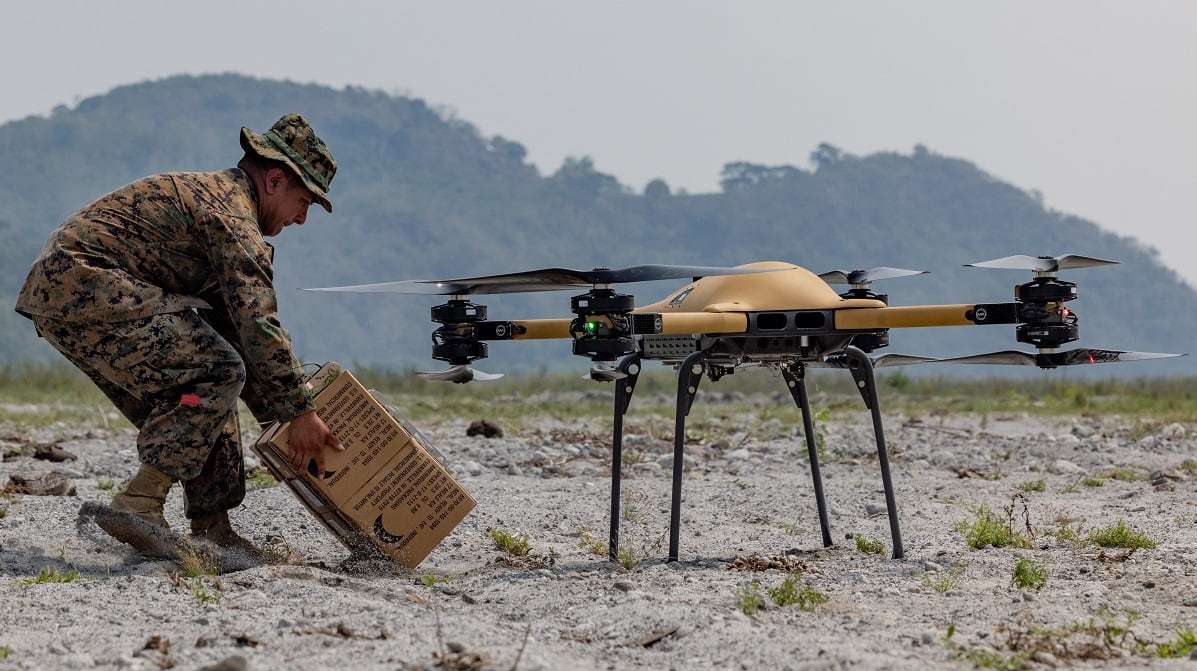Amazon may have had the vision, but the Marine Corps is making it reality.
After years of experimenting with airborne delivery drones, the service believes it has a winner.
In its fiscal 2024 budget request, the Marine Corps is asking to buy 41 tactical resupply unmanned aircraft systems, or TRUAS, for a total investment of more than $13 million.
With the service set to take delivery of previous orders of the drones this spring and expecting to declare initial operational capability on the system later this fall, it will be a big year, not only for tactical resupply unmanned aircraft systems, but also for the concept of unmanned aerial resupply.
Built like large quadcopters, the systems are designed to carry payloads of up to 150 pounds over distances of up to nine miles in containers secured underneath. The unit cost of about $325,000 per drone is certainly steep, but Marine officials say it’s substantially more sophisticated than the remote-controlled commercial drones it resembles.
Rather than being manually flown, tactical resupply unmanned aircraft systems are programmed with waypoints that determine itinerary and flight pattern, meaning it requires less hands-on attention from Marine operators than most of the Corps’ quadcopters.
It takes just two Marines to monitor and maintain one in the field, and those Marines can learn everything they need to know about taking care of it in just five training days, according to Master Sgt. Chris Genualdi, an airborne and air delivery specialist with Combat Development and Integration, who discussed the system in an April news release.
The tactical resupply unmanned aircraft systems concept is closely aligned with the Marine Corps’ all-consuming vision for future warfare, which involves small, independent units operating from great distances from austere outposts ― perhaps on islands in the vast Indo-Pacific.
While the system isn’t designed to cross the ocean with supplies, it might be dispatched from a ship to a landing zone in hostile conditions ashore that might preclude a helicopter or V-22 Osprey delivery.
“As system technology advances in future years, [Unmanned Expeditionary Systems] will … include emerging technologies to include autonomous distribution capabilities for elements across the MAGTF and [Marine Littoral Regiments], enabling more diversified distribution and the sustainment of Marine Corps forces across future operating environments,” officials wrote in fiscal 2024 budget justification documents.
Tactical resupply unmanned aircraft systems provide “an organic battlefield logistics capability to distribute critical supplies via an unmanned platform while conducting” expeditionary advanced base operations safely within a weapons engagement zone, “where the risk to manned aircraft would deny manned aviation resupply operations.”
Marine leaders plan to scale the technology as it proves itself, according to the April news release, eventually building larger and higher-capacity platforms according to the same model that might further advance the objectives of the Corps’ expeditionary advanced base operations.
To this end, the service is also planning to launch a new military occupational specialty, or military job, focused on operating resupply drones. That job will be called small unmanned logistics system — air specialist. The timing of its rollout has not been announced.
In April, defense contractor Leidos announced a contract with the Marine Corps to build a larger autonomous drone prototype ― similar to a helicopter with a double stack of rotors ― that would be able to travel up to 100 nautical miles and carry up to 600 pounds.
“The utility of the TRUAS reaches beyond combat,” the recent Marine Corps release states, with its capabilities being highly effective in humanitarian assistance and disaster relief efforts.
“In disaster areas that may not be accessible by conventional means, the TRUAS could be used to transport much needed supplies.”
The Corps contracted for 35 tactical resupply unmanned aircraft systems drones in August 2022 and 30 more in March 2023, according to Marine Corps budget documents, but all are set for delivery in the first half of this year from SURVICE Engineering, out of Aberdeen, Maryland.
The effort to develop the tactical resupply unmanned aircraft systems began in earnest with a Department of the Navy “fly-off” prize challenge launched in 2020 at Yuma Proving Ground, Arizona, to build a rugged and reliable small cargo-carrying drone. SURVICE took the $100,000 first-place prize in that effort.
While tactical resupply unmanned aircraft systems only have been employed in field user evaluations and training and not proven in combat, the Marine Corps has moved relatively quickly to make its delivery-drone requirement a reality.
It’s far from the only entity seeking to capitalize on reliable unmanned aerial logistics. In 2013, online retail giant Amazon made headlines when then-CEO Jeff Bezos announced that it would be delivering packages via aerial drone by 2018.
A decade later, Amazon has launched a very limited regional version of the service, and the company says it’s still working on developing its vision for “Amazon Prime Air.”
Hope Hodge Seck is an award-winning investigative and enterprise reporter covering the U.S. military and national defense. The former managing editor of Military.com, her work has also appeared in the Washington Post, Politico Magazine, USA Today and Popular Mechanics.








